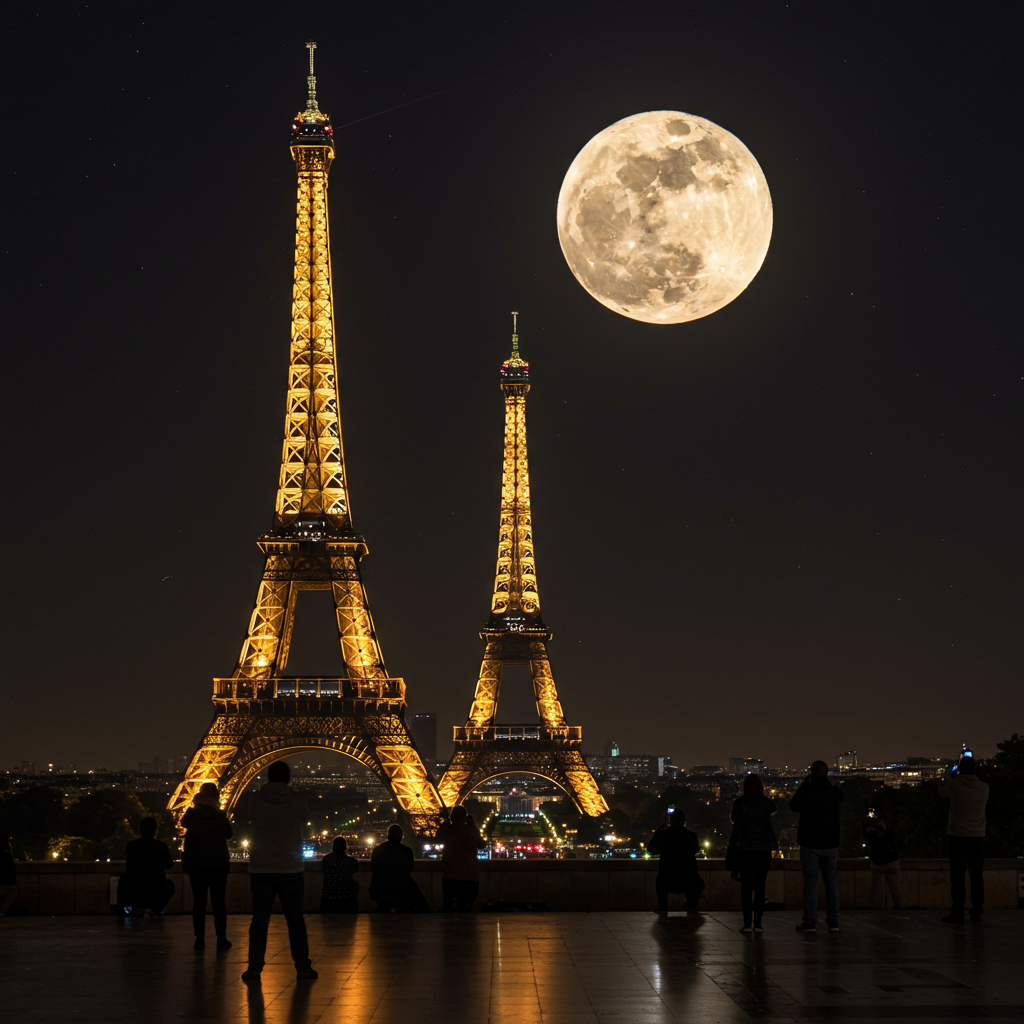October 2025 brought an exceptional celestial spectacle: the Harvest Supermoon. This captivating event, the first supermoon of the year, dazzled skywatchers globally with its enhanced size and brilliance. As the moon swelled to appear up to 14% larger and 30% brighter than average, photographers and casual observers alike captured its breathtaking rise. This article dives into the science behind this rare occurrence, showcases stunning images from around the world, and offers tips for future skywatching. Prepare to be amazed by the ultimate guide to the 2025 Harvest Supermoon.
The Science Behind a Supermoon Spectacle
Understanding why October’s moon was so special begins with two key astronomical phenomena. First, the term “Harvest Moon” refers to the full moon that falls closest to the autumn equinox. Historically, this meant farmers could work longer under its generous light, gathering crops before winter. While typically seen in September, the 2025 Harvest Moon unusually graced our skies in October, marking its latest appearance in over 35 years.
Second, this particular Harvest Moon was also a supermoon. This designation occurs when a full moon coincides with the moon reaching its perigee – the point in its elliptical 27-day orbit where it is closest to Earth. On October 6th, the moon was approximately 361,000 kilometers (224,599 miles) from our planet, significantly closer than its average distance. This proximity explained its noticeably larger and brighter appearance, creating a truly spectacular display as it ascended over the eastern horizon, directly opposite the setting sun.
Why the Moon Glowed Yellow and Orange
Many observers were captivated by the moon’s striking yellow or orange hue, especially when it was low in the sky. This vibrant coloring isn’t an intrinsic property of the moon itself but rather an atmospheric effect called Rayleigh Scattering.
Atmospheric Interference: When moonlight travels through Earth’s dense atmosphere, shorter, bluer wavelengths of light are scattered more efficiently.
Red and Orange Penetration: Longer, redder, and yellower wavelengths, however, pass through with less interference.
Visual Result: This allows the red and orange light to reach our eyes more directly, making the moon appear in these warm tones, particularly when viewed near the horizon where light travels through more atmosphere.
This natural phenomenon transforms a bright white moon into a painter’s canvas of golden and amber tones, enhancing the visual drama of its rise.
A Global Gallery of Celestial Wonders
Astrophotographers and skywatchers across the globe immortalized the 2025 Harvest Supermoon with incredible images. From iconic landmarks to serene landscapes, each photograph tells a unique story of humanity’s connection to the cosmos.
Here’s a collection of some of the most memorable captures:
Washington D.C., USA: Austin DeSisto captured a perfectly timed shot of the full Harvest Moon passing behind the iconic Washington Monument. Wisps of clouds and lunar surface features added depth to this stunning urban composition.
New York City, USA: Veteran photographer Gary Hershorn snapped a breathtaking view of the yellow supermoon hovering above the Statue of Liberty as seen from New Jersey City. He also caught the moon peeking around the EdgeNYC observation deck a night earlier.
Kathmandu, Nepal: Amartya Mishra delivered a spectacularly detailed image, highlighting the moon’s increased brightness and size. His photo clearly revealed prominent lunar features like the dark lunar maria (seas), bright streaks of ejecta from craters such as Copernicus, Kepler, and Tycho, and vast mountain ranges like Montes Apenninus and Montes Jura.
Jinhua, China: Gong Xianming photographed the supermoon rising during the Mid-Autumn Festival, or Moon Festival. This ancient 3,000-year-old tradition from the Zhou Dynasty, celebrating family reunions and moon appreciation with mooncakes, gained extra magic from the supermoon.
L’Aquila, Italy: Lorenzo Di Cola captured the moon suspended above a cloud bank over the tranquil hills, with the historical Rocca Calascio Castle and Santa Maria della Pietà church visible on the horizon.
West Java, Indonesia: Aditya Irawan achieved a perfectly timed shot of a passenger jet silhouetted against the supermoon’s face, adding an unexpected element to the celestial display.
Palayan City, Philippines: X user “loonarpix” shared a vibrant, colorful view of the full moon.
Global Observations: Reports and images poured in from places like Goole and Beverley Minster in East Yorkshire, UK, where the moon was noted for its exceptional size and brightness. Other stunning sightings included an airplane against the moon in Singapore, the moon setting behind a mosque in El-Shorouk, Egypt, rising over the Gulf waters off Kuwait City, illuminating the Metropolitan Cathedral in Bogota, Colombia, and appearing dramatically behind windmills in Campo de Criptana, Spain. A red supermoon was even observed over Fort Saint Angelo in Grand Harbour, Malta.
These diverse perspectives underscore the universal appeal of the Harvest Supermoon.
Maximizing Your Next Skywatching Experience
While the October 2025 Harvest Supermoon has passed, similar celestial events are just around the corner. The moon will continue to appear relatively full to casual observers for a day or two following its official peak. This extended viewing window offers more opportunities for enjoyment and photography.
Tips for Observing and Photographing Supermoons
Timing is Key: For the most dramatic visual, watch the moon rise (or set) over the eastern (or western) horizon. This is when Rayleigh Scattering is most pronounced, creating those stunning yellow and orange hues. Check local moonrise and moonset times.
Find an Unobstructed View: Seek an elevated location with a clear, open horizon. Cityscapes can offer unique foreground elements, as seen with the Washington Monument and Statue of Liberty photos.
Binoculars for Detail: While the supermoon is impressive to the naked eye, a good pair of stargazing binoculars can reveal intricate lunar craters and vast maria (dark lava plains) in incredible detail. For more advanced viewing, a beginner-friendly telescope like the Celestron NexStar 4SE is an excellent choice.
Photography Gear: For capturing breathtaking shots, consider investing in a camera with manual controls, a sturdy tripod, and a telephoto lens. Many astrophotography guides can help you master long exposures and focus techniques.
Look for Companions: During the 2025 event, Saturn was visible close to the moon in the constellation Pisces. Always check for planets or bright stars that might share the frame with future full moons.
By preparing ahead, you can make the most of every upcoming lunar display.
Future Celestial Highlights: What’s Next?
The October 2025 Harvest Supermoon was just the beginning of a lunar treat. This event was the first in a series of three consecutive supermoons. Skywatchers can anticipate further dazzling displays in:
November 2025: The Beaver Moon, predicted to be the largest supermoon since 2019.
December 2025.
- January 2026.
- www.space.com
- www.bbc.com
- www.livescience.com
- www.bbc.co.uk
- www.wionews.com
Beyond full moons, October offered other compelling astronomical events. The annual Draconid meteor shower peaked around October 8th, though the bright supermoon likely made spotting its expected 10 meteors per hour challenging. Later in the month, the Orionid meteor shower on October 21-22 promised better viewing conditions under a darker new moon sky. Additionally, two comets, Lemmon (C/2025 A6) and SWAN R2 (C/2025 R2), made their closest approaches to Earth, providing diverse targets for astrophotographers.
These upcoming events ensure that the night sky continues to offer endless fascination and photographic opportunities. Keep an eye on astronomy calendars and local skywatching forecasts to catch the next spectacular show.
Frequently Asked Questions
What made the October 2025 Harvest Moon a “supermoon”?
The October 2025 Harvest Moon was classified as a supermoon because it occurred when the moon was near its perigee, the closest point in its elliptical orbit around Earth. On October 6th, the moon was approximately 361,000 kilometers (224,599 miles) away, significantly closer than its average distance. This proximity caused it to appear up to 14% larger and 30% brighter than a typical full moon, creating a more dramatic visual display for skywatchers.
Why did the Harvest Supermoon sometimes appear yellow or orange?
The moon’s yellow or orange hue, particularly when viewed near the horizon, is due to a phenomenon called Rayleigh Scattering. When moonlight passes through more of Earth’s dense atmosphere at a low angle, shorter, bluer wavelengths of light are scattered away. Longer, redder, and yellower wavelengths, however, pass through more directly, reaching our eyes and giving the moon its distinctive warm coloration. This is a common atmospheric effect, not unique to supermoons.
What are the best tips for photographing an upcoming supermoon?
To photograph an upcoming supermoon, focus on timing and equipment. Plan to shoot during moonrise or moonset for the most striking colors caused by atmospheric scattering. Use a sturdy tripod to avoid camera shake, a camera with manual controls for adjusting exposure and focus, and a telephoto lens to capture lunar details. Consider incorporating foreground elements like landmarks or landscapes to add scale and interest to your composition. Practice beforehand to get comfortable with your gear and settings.
Conclusion
The October 2025 Harvest Supermoon was a truly memorable celestial event, captivating observers with its enhanced brilliance and size. From the scientific intricacies of its perigee and the atmospheric magic of Rayleigh Scattering to the diverse, breathtaking photographs captured across continents, it served as a powerful reminder of the beauty and wonder of our universe. As the first of several upcoming supermoons, it sets the stage for more incredible skywatching opportunities. Don’t miss the chance to gaze upon these magnificent lunar displays and perhaps even capture your own stunning images of Earth’s luminous companion.




